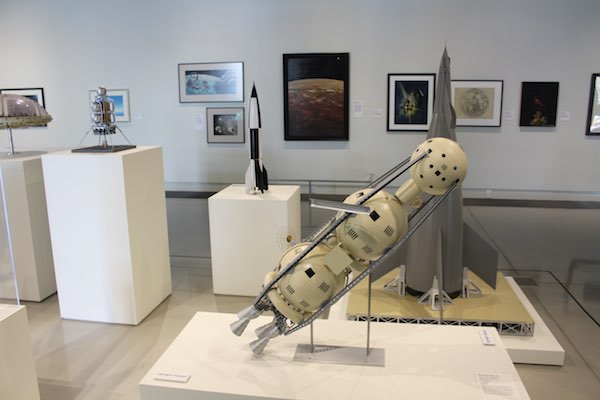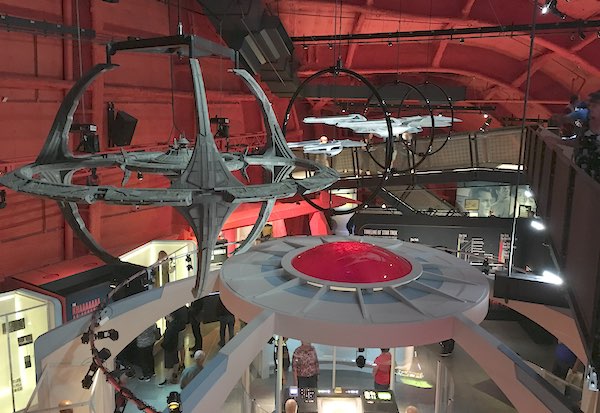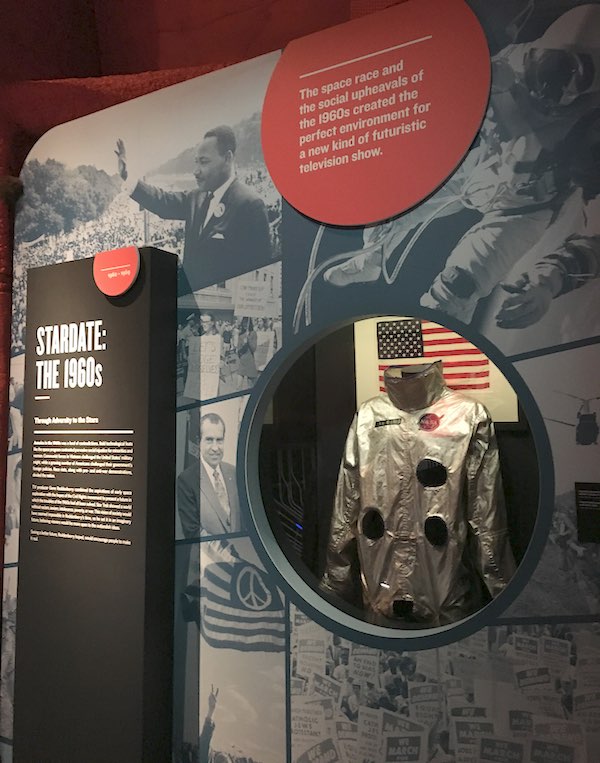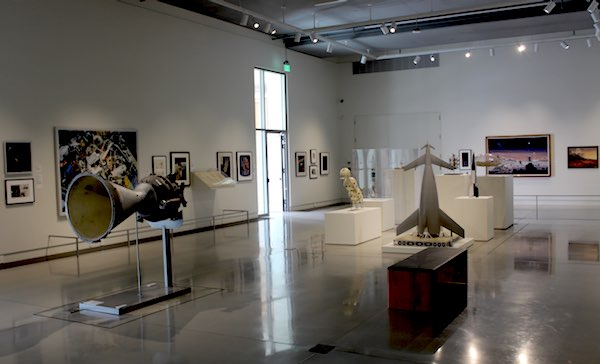Storytelling with space art and artifactsby Jeff Foust
|
| “I love you people, but you’ve got to understand: you love your machines much more than most people do,” advised O’Brien. |
Storytelling, though, can be more than just promoting interesting people involved with companies and missions. There’s long been an interplay between fact and fiction, reality and fantasy, each feeding off the other to offer visions of humanity future in space. A couple of museum exhibits within walking distance of the conference hotel in downtown Seattle offered some glimpses of how that can work.
“Imagined Futures” is an exhibit at the Pivot Art + Culture gallery located within the Allen Institute building near Lake Union. The “Allen” of the Allen Institute is Microsoft co-founder Paul Allen, and the exhibit is comprised of items from Allen’s own collection of art and artifacts.
 The exhibit includes several models of Von Braun concepts for launch vehicles and lunar landers. (credit: J. Foust) |
The exhibition, according to the gallery, “explores the visualization of new space frontiers through works of art by modern masters of the speculative and fantastic.” It’s primarily a collection of artwork that depicts space exploration in one manner or another, from classics by Chesley Bonestell to more recent works by Don Dixon and Ron Miller. There are also models of both von Braun’s V-2 and his proposals for orbital launch vehicles and lunar landers.
That art is accompanies by a little bit of actual artifacts of spaceflight and space exploration. There is an XLR-99 engine used on the X-15 on display, as well as an IBM 360 computer like those used during the Apollo era. They are the exceptions, though, to an exhibit dominated by artwork and conceptual models.
Outside of the main gallery room, there is a separate art installation called “voyager one.” It is concept art created for this exhibition: you go inside a darkened room where the only light is from a single LED suspended from the ceiling. That light changes color to represent the distance of the Voyager 1 spacecraft from the Earth—but so slowly as it’s impossible to perceive any changes while you’re in the room, or even for the duration of the exhibition. “The pin-point of colored light emitted by the LED device parallels our experience of gazing skyward and looking for a sign from this distant muse,” an explanation accompanying the art installation explains. Okay, then.
While the exhibit is designed, according to the gallery, to address “the challenges of imagining the multiple realities of the unknown,” it’s hard to see a clear, coherent story being told by what’s on display. It’s interesting to look at the individual items on display, but put together they seem less than the sum of their parts. For $5, though, it’s worth a look if you’re in Seattle in the next couple of weeks (it closes July 10), and you may not have a lot of company: during a visit late on a Friday morning, there was no one else in the gallery.
| The pin-point of colored light emitted by the LED device parallels our experience of gazing skyward and looking for a sign from this distant muse,” an explanation accompanying the art installation explains. Okay, then. |
There are plenty of people, though, at the nearby EMP Museum, in the shadow of the Space Needle. Originally known as the Experience Music Project, the EMP Museum is now a mix of exhibits about music, video games, and science fiction. The museum is hosting a special exhibition this summer about Star Trek to mark the 50th anniversary of the science fiction franchise.
 A view of some of the items, like models of Deep Space Nine and iterations of the USS Enterprise, at the EMP Museum exhibit. (credit: J. Foust) |
The exhibit features what you might expect: a collection of costumes, props, and starship models from the various series and movies. It’s really intended for people who are already fans of the show; visitors were gawking at, and taking photos of themselves with, the various items on display, like part of the bridge from the original series.
Star Trek, of course, excelled at storytelling, and provided a vision for the future that inspired generations of people to pursue careers in space. There’s not much of that link between science fiction and fact on display, beyond a video in an upper level of the exhibit that discusses the broader cultural impact of Star Trek. Elsewhere, there’s a brief discussion of the role in the 1960s played on the original series, including the inspiration the series took from the early space program. A silvery NASA garment from the Gemini program is on display with the nametag “E. H. WHITE II” on it, indicating it was worn, or at least assigned to, the late Ed White, although the description of the item doesn’t offer more details about it.
 A Gemini-era NASA garment, with Ed White's name, is the one real space item on display at the Star Trek exhibit. (credit: J. Foust) |
The crowds in the exhibit (which requires an additional charge to the museum’s regular fee, for a total of $30 for adults) do demonstrate the interest and staying power of Star Trek that transcended the storylines and special effects. That doesn’t mean NewSpace companies should abandon technologies and business plans for good stories, but that storytelling, like the personalities O’Brien described, can help stoke interest beyond those companies’ customers and advocates.
